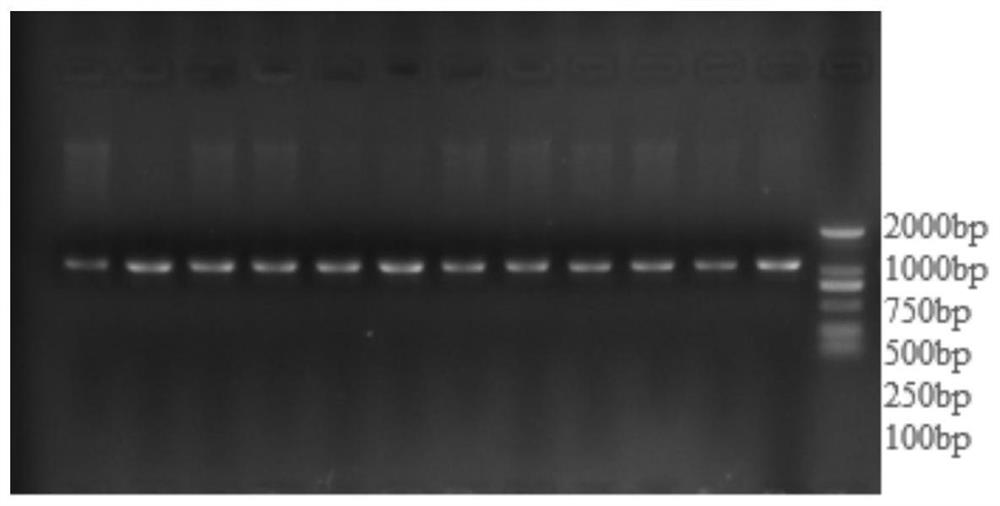Molecular marker capable of affecting abdominal fat percentage of chicken, and application of molecular marker
A technology of molecular markers and abdominal fat rate, which is applied in the field of molecular markers of abdominal fat rate, can solve the problems of affecting broiler slaughter and processing, reducing feed utilization rate, increasing economic benefits, etc., so as to improve chicken slaughter rate and feed utilization rate, The effect of reducing abdominal fat rate and improving economic benefits
- Summary
- Abstract
- Description
- Claims
- Application Information
AI Technical Summary
Problems solved by technology
Method used
Image
Examples
Embodiment 1
[0035] Example 1 Primer Design
[0036] 1. Experimental method
[0037] Find the sequence of the 3' non-coding region of the ALDH1A3 gene from https: / / www.ncbi.nlm.nih.gov / , and design a primer pair. The primer pair information is shown in Table 1 (primer sequence 5'→3'). The sequence of the primer pair was sent to Guangzhou Sangon Biotech Co., Ltd. for synthesis, and the primer pair was used to perform PCR on tissue DNA to test the specificity of the primers.
[0038] Table 1 Primer information for SNP screening of ALDH1A3
[0039]
[0040] 2. Experimental results
[0041] The results are attached figure 1 shown. Use this primer pair to carry out PCR on blood DNA, as attached figure 1 As shown, the primers are specific.
Embodiment 2
[0042] Example 2 DNA pool sequencing
[0043] 1. Experimental method
[0044] The sample chickens were selected from the 120-day-old Nanhai jute chicken No. 1 pure line of Jiangfeng Chicken Farm. All chickens were hatched in the same batch, raised in a flat rearing manner, and fed corn-soybean meal-based feed that complied with international formula standards. Use a 2ml syringe to collect blood from the subwing vein, collect the blood and store it in a centrifuge tube containing 20% EDTA for blood DNA extraction.
[0045] Genomic DNA of all individuals based on Plant Mini Kit (Qiagen, Hilden, CA; Cat#69104) was used in the kit instructions to extract blood DNA, measure the quality and concentration, dilute to 50 ng / μL, and store at 4°C for later use.
[0046] 30 DNA samples were randomly selected from the total extracted DNA samples to construct a mixed pool, and every three samples (about 0.33 μL of each sample) were mixed into a mixed sample, a total of 10 samples. The...
Embodiment 3
[0049]Example 3 Determination of the genotype of the ALDH1A3 mutation site g.941T>C
[0050] 1. Experimental method
[0051] Before slaughtering, all chicken samples were tested for indicators, in accordance with the Agricultural Industry Standard of the People's Republic of China "Poultry Production Performance Terminology and Measuring and Statistical Methods" (NT / T823-2004). Among them, the subcutaneous fat thickness and intermuscular fat width were measured with a vernier caliper, and the shin circumference and shin length were measured with a soft ruler. After the chickens were bled, scalded and plucked in a unified line in the slaughterhouse, they were gently wiped dry with paper towels, and the cloaca, shin (cuticle removal), Determination of the yellowness value of the shoulders, buttocks, chest, belly and abdominal fat.
[0052] A database was established with Excel, and individuals with incomplete trait data records and outliers were deleted during the initial scre...
PUM
 Login to View More
Login to View More Abstract
Description
Claims
Application Information
 Login to View More
Login to View More - R&D
- Intellectual Property
- Life Sciences
- Materials
- Tech Scout
- Unparalleled Data Quality
- Higher Quality Content
- 60% Fewer Hallucinations
Browse by: Latest US Patents, China's latest patents, Technical Efficacy Thesaurus, Application Domain, Technology Topic, Popular Technical Reports.
© 2025 PatSnap. All rights reserved.Legal|Privacy policy|Modern Slavery Act Transparency Statement|Sitemap|About US| Contact US: help@patsnap.com



